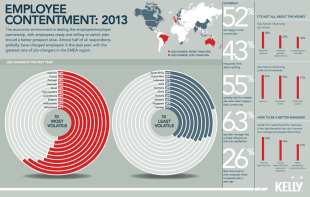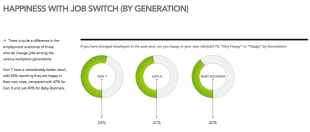A couple of generations ago, the idea of having more than one or two career positions after high school or college was entirely unthinkable. The idea was to go to school, go to interviews, take an offer, stay there for 35 years, and retire with a pension, all the while enjoying some benefits like paid vacations and health insurance. While all of this was attractive to those who were able to attain it, those on the fringes longed for something more. That “something more” was often an insatiable appetite for something that just wasn’t possible—not like it is today.
 Creative Employee Retention: Keep the Talent Show in Your Office
Creative Employee Retention: Keep the Talent Show in Your Office
It’s not that we’re more talented than we used to be, it’s that we have many more options. In many markets, the creatives are calling the shots, naming their prices, and deciding who they’d like to work for. And often, much like true mercenaries, such creatives work for more than one enterprise that needs the skill set they have—at the level they have it.
There are people who can use Photoshop, and then there are people who can sit in Adobe Illustrator for an afternoon and generate an infographic that represents your entire company culture. Not only does it present all the info you sent them in that memo, it’s bright, polished, beautiful, and looks great in print, on your website, your social media platforms, and more.
 Creative Employee Retention: Keep the Talent Show in Your Office
Creative Employee Retention: Keep the Talent Show in Your Office
So given the difference of spending a little more, will you hire the Photoshop guy who can put together a slapdash presentation or will you do the right thing and get that graphic designer who gives you something incredible: more than you expected, and likely, once you’ve really looked at what they’ve turned out, you’re probably seeing elements you didn’t even know you wanted included… but now that they’re in place, wow, what a difference.
But there’s a tacit understanding among creatives. They are largely contract workers, they are largely freelance, and they can come and go as they please. The same is true for those with whom they work—companies who contract such creatives are free to let them go at any time without notice because they are not W2 employees. Plus they don’t owe these artistic contractors any benefits, so it’s an attractive proposition unless you make it unattractive to the creative contractor by offering him or her a rate that’s far below market value. The old adage, “you get what you pay for” applies here like nowhere else. Look at the incredible onslaught of SEO and article writers, designers, and more working remotely from India and China.
Many are good at what they do and insanely cheap, but there’s generally some level of language barrier, and it’s such a mixed bag with so many variables for upset (especially on deadlines) that you wind up paying far more in the end to have a mainland professional come in to mop up the mess and start all over again. This doesn’t mean outsourcing abroad is always a bad thing, but when it comes to crafting that infographic for the big meeting with Baby Einstein, you’ll wanna keep things stateside with a proven, credentialed creative who has a spotless, proven portfolio.
 Creative Employee Retention: Keep the Talent Show in Your Office
Creative Employee Retention: Keep the Talent Show in Your Office
Once you have them in your grip, the job of keeping a creative who continues to turn out quality work can be a tough one. Better wages elsewhere, retainers being offered to them by bigger firms that will look better on their resumes, and being able to live where they choose and/or work remotely are all enormous bullet points on the short list of the creative contractor.
If you want to hold on to a great creative, meet with them for a review every six months just as you would with an employee. Discuss their performance, and let them tell you what they feel they deserve in exchange for their exceptional work and performance. If they’ve made your company a lot of money in a six to twelve month period, they are probably worth everything they’re asking for, which usually boils down to working from home, working on a retainer, or an inclusion of benefits despite their contractor status. Keep them happy, and they will continue to put on the best talent show your company has ever seen.
Hard workers are hard to find—hard workers who produce superior work are even harder to find, and those who can do it from home (which by the way lowers your overhead and is better for the environment) and still meet deadlines are even rarer. So when you find one of these endangered species, do what you can to be inclusive, make them feel at home, and perhaps most importantly, network with them.
Creatives know other industry professionals who may be a great fit for your team. That amazing infographics guy you hired probably has a crack content editor buddy, who also has a social media platform whiz pal, and so on. Let it all work to your benefit, remembering that when you have a mutually respectful relationship in which both quality craftsmanship and quality treatment are valued, the sky is the limit. You can even create an infographic that explains it if the mood strikes.
Infographics Via: Kelly OCG
More Business articles from Business 2 Community:




